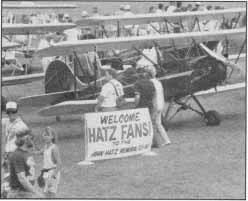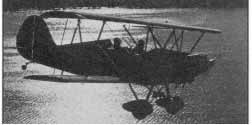Page Three
 |
The airplane attracts
the kind of people you'd expect: laid back and friendly |
Frank had told me to pick it up off the ground at some air-speed
number which I had totally forgotten. That didn't worry me since
my usual tactic in this situation is to set the airplane up in a
slightly tail low attitude and let it fly off when ready. With this
in mind, I swung the go-lever forward and put my head back to concentrate
on peripheral vision and the parts of the runway that showed on either
side of the nose. The sight picture is not unlike that in a Cub,
or better yet, from the back seat of an Aeronca Champ.
This is to say the runway stripe I was sitting on was invisible but
there was so much runway on either side of the nose, it would be
impossible not to know what the airplane was trying to do. In this
case, with the Lycoming clattering away whatever the airplane was
trying to do was being done at such a leisurely pace even a very
low-time pilot would have no trouble keeping up.
The tail came up almost as soon as I put a reasonable amount of forward
pressure on the stick, giving an omni-view of the run-way ahead.
Actually, I didn't have time to begin to enjoy the view or even begin
loading the stick aft before the airplane floated off the ground.
I dropped the nose only slightly to get a climb speed of 65 mph before
establishing a shallow climb attitude.
Even after the airplane lifted off and settled into a 400-500 fpm
climb, I remarked how natural this airplane felt. There was absolutely
none of the feeling that comes with flying a strange new airplane
and part of that was because there was nothing about the airplane
that was either new or strange. If my vision hadn't been cluttered
by wires and struts and windshield framing, I could have been flying
a Champ, which is the closest valid comparison — assuming there
is anything that can compare to a nostalgic looking, 115
hp open cockpit two-place biplane.
Frank Sr., the Hatz and I sat in a solid groove as we worked to put
a couple thousand feet between us and the Wisconsin real estate.
It was during the climb that I was able to sit back and enjoy the
morning from one of the better perches available. Visibility had
to be 50 miles or better and Wisconsin is a great backdrop for all
the neat old stuff hanging off the Hatz airframe — giving an
impression as if I were part of a Currier and Ives etching done from
the inside of a mailplane headed west.
When 2000 feet showed up, I pushed the nose over and brought the
power back to keep the engine in the 2400 rpm range while the airspeed
gradually worked up to 90 mph. As the speed was coming up, so did
the wind noise and the buffet on the top of my head. At no time,
however, was there anything even remotely resembling turbulence in
the cockpit. There was only a gentle tugging at the helmet's top
by a playful bit of the slipstream that didn't want me to forget
what kind of an airplane I was flying. And I didn't.
I had expected the airplane to have adverse yaw out the ears, so
I was really surprised when I shoved the stick to one side without
rudder and found the nose slid the other way for only a second before
obediently following the stick. Most airplanes with that amount of
wing and aileron would have had so much adverse yaw, the nose would
have slid the opposite direction and stayed there. The Hatz didn't
have any such tendency. The rudder has lots and lots of authority,
so only a gentle amount of pressure was needed to keep the nose on
a point during Dutch rolls and to keep the ball centered during turns.
In pitch, the airplane did display an interesting stability phenomenon
that appeared to be independent of the control system:
If the stick was pulled or bumped back and then released, the stick
stayed back while the nose kept coming up. This situation
gave no indication of reversing so long as the stick was free. It
was totally neutral in that respect.
Carb heat out and power back, I didn't have to wait long for the
speed to bleed off to the low 40s. There I found the stick in my
lap and the nose sort of hanging there in a gentle mush. I tried
accelerating the stall in a hard turn and still got the same noncommital
mush with no break. At this point the airplane was settling fairly
fast with no buffet or other warning stating it was all done flying.
This is a pretty common characteristic for airplanes of its type
(I almost wrote "of its age"), which means it would be
possible to bleed off speed accidentally and tip-toe into a stall
without knowing, since the aircraft has no distinct break. Since
the Hatz is a dirty biplane with lots of drag, the approach should
be made on the high side, around 70 mph, knowing well the second
the power is back and the nose is up, all that speed will disappear.
There is practically no excuse to get the Hatz slow enough to worry
about a stall.
The control tower asked us to enter the pattern on the south-west
corner of the field and, as I did, I saw the obliging green light
aimed at us and we were number one to land. Opposite the end of the
runway, I got the carb heat and power back and immediately
had the sense the airplane was giving up altitude quickly. It was
as if the airplane was talking, trying to tell me to fly a tight
pattern, since it had the drag coefficient of a cotton ball and glide
angle of a well-fluffed pillow. Holding 70 mph, I kept just enough
power that I turned final knowing I had the runway made before killing
the power completely. At no point did the runway disappear
behind the nose. Just the opposite was true: Until I was deep into
the flair, the runway was always in plain view.
As the runway came up, I fought the urge to break the glide as with
a Cub or Champ. Something in the airplane was telling me it would
be a smart idea to break the glide much, much lower. As
we came into ground effect and I started the nose up, the airplane
kept whispering, as the speed bled off and worked its way down through
ground effect. The Hatz rotated and settled almost as if in autoflair
mode. There is something about the ai-plane that very clearly telegraphs
intentions to the pilot's right hand.
Throughout the approach I had been concerned that I had been so pre-occupied
with the tailwheel steering during taxi that I hadn't really nailed
down the three-point nose attitude in my mind. On flair, I approximated
what I thought to be three-point and just as the airplane sighed
and quit flying I felt the tailwheel touch a fraction ahead of
the mains. As it squatted onto the runway, I had to fight another
urge and that was to get my feet involved in the question of directional
control. The airplane was rolling straight and it was obvious all
I did by trying to help it was screw things up. If the airplane touches
straight, the pilot would be better off crossing his feet and ignoring
both the rudder and brakes. If there were rudder springs in the linkage
and things weren't so direct, it would be easier for the pilot to
keep from over reacting.
Once on the runway, the Hatz decelerated so quickly, it caught me
unaware and it took a fair amount of power to get down to the next
taxiway fast enough to clear the Bonanza on final. I landed,
turned off the runway and pulled into a parking spot before I realized
I hadn't touched the brakes during the entire episode.
 |
I wish the magazine
had run this in color as it's a really pretty shot of the
airplane. |
Of all the little airplanes I've had the luck to
fly, this one has to be the most "natural" feeling. Practically everything
will outrun the Hatz and there's no comparing the biplane with any
of the new build-it-in-a-weekend kits that do Mach 1, but there aren't
any airplanes with a higher fun quotient or are more honest. Honesty
in an airplane is often talked about, but the Hatz is one of the
few that give honesty a "voice" that continually lets the
pilot know what is coming next.
The Hatz is an old-fashioned homebuilt that can be built at exactly
the speed the money comes in. The newer kits require a heavy hit
right up front, most in the area of $20,000 (Ed
Note: Ah, the good old days of the early '90's). We tend to forget that not all homebuilders
are wealthy and some have more time and talent than money. With airplanes
like the Hatz, if a builder has an extra $75 laying around, he can
buy some tubing and build the tail. The next $75 can go for rib material.
The only upfront money is the $125 for the plans. The rest is put
in only when it is available. Also, assuming $7500 for the engine
and a little scrounging for the rest, the entire airplane shouldn't
cost much over $15-$18,000. That's a lot of money, but much less
painful when it goes in a little at a time and doesn't come close
to the costs of the high-end machines that are so common today.
The Hatz has a lot going for it. Quick building and speed are not
among its strong points. But fun and good manners on the runway definitely
are. This is an airplane a lot of folks ought to be building, but
aren't. One flight should change their minds. BD
For
lots more pilot reports like this one go to PILOT
REPORTS
|


